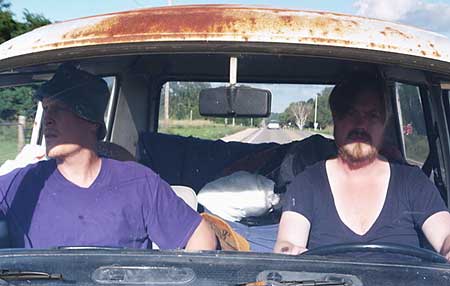PAY TO PLAY
YouTube's Sara Pollack discusses the site's revenue-generating new distribution model.
By Alicia Van Couvering
PRINCESS OF NEBRASKA. PHOTO BY: RICHARD WONG.
One of the most visible signs of change in the distribution landscape at Sundance this year were the YouTube movies: the three 2010 films that premiered on the site during and after the fest, along with three films from Sundance 2009. Did the experiment work? Was Bass Ackwards's number of views on the first day good or bad? Did Children of Invention's availability there generate overall buzz in the marketplace? Was it the pioneering shift in distribution strategy that some claimed or, as others argued, a failure given the low number of rentals (hundreds, not thousands) most of the titles garnered?
These are the questions we posed to Sara Pollack, the entertainment marketing manager at YouTube, both during and three months after the festival. Approaching her three-year anniversary at YouTube (her "Google birthday," as they call it internally), she began her career at the production company GreenStreet. From there she moved to Miramax to work for production head Meryl Poster, then moved over to Big Beach where she became a production exec overseeing Little Miss Sunshine and Everything Is Illuminated, and was about to start on Sunshine Cleaning when she was snatched up by Google to figure out how to empower filmmakers on the Web.
"Sundance was an experiment," she says gamely. "There's no question in my mind that the initiative helped these films increase their audiences, and that was the goal."
"The idea that YouTube was 'a place for film' has been in existence for some time," she continues. Arin Crumley and Susan Buice's film Four Eyed Monsters, one of the first features to air on the site in 2007, was "the perfect film to start testing the waters." The Four Eyed team had already built an enormous social network, been playing clips about the making of their film on YouTube, and were employing a multiformat interactive Web-based way of making and marketing their movie that had deep appeal to a young, wired audience.
Since then, a lot of very different films have begun to play in their entirety on the site, and a number of different methods of monetization have been set up by the company.
Says Pollack, "Luc Besson put his film Home on site last June, Wayne Wang premiered The Princess of Nebraska here on the YouTube Screening Room with about 200,000 hits the first weekend, which was equivalent to a very high box-office ranking. "Several films have chosen to go online for free, "usually documentaries dealing with political or activist issues," notes Pollack, such as the Oscar-nominated documentary No End in Sight.
Pollack says that her real goal is to empower filmmakers by offering as many choices and as much freedom as possible. "The ad-supported model doesn't work for everyone," she points out. (That model occurs when Google decides that you have enough of the right kind of content to partner with you, in which case you are deemed "monetizable," and YouTube can begin selling ads to appear in and around your videos.)
BASS ACKWARDS.
The Sundance films this year were operating on a rental model, but what's different about it for Pollack is that filmmakers "choose the price that they want to set for their films. You know your film best, you know your audience best, you know how to reach them and know what they think they should or want to pay, so you make the decision about how much you want to charge them." The majority of the revenue goes to the filmmaker, and the filmmaker can decide the term of the rental as well - maybe $1.99 buys someone three hours of your movie, maybe $10.99 buys them 90 days. The agreement is non-exclusive, and the revenues - as indicated by the number of views - are transparent.
"It's really about giving filmmakers and content creators choices as to how they want to reach their audiences because we're just trying to get as much content on the site as possible for our community," she says. "The best way to do that is by giving partners more choice about how they monetize and distribute their work."
What makes YouTube different from other online viewing sites? Pollack thinks it's the viewers, not the platform: "[YouTube users] not only watch content, they rate it, they share it, they comment about it; it's really about creating a conversation around videos. These films inspire a lot of debate over characters, over storylines, over distribution models. The site built around this diversity of content that's about what's happening right now - whether it's censored video of protests in Iran that gets spread around the world or the latest sports thing that everyone is talking about - I think that really carries over to movies. What's new, what's relevant, what's fresh?"
Still, for all the excited press the YouTube Sundance partnership generated, there were many who dubbed it a failure. Indeed, on the festival's close the numbers were poor, with The Cove, which went on to win the Best Documentary Academy Award, scoring the most views at 303. The possible reasons cited for the low number of rentals was diverse. Brian Newman, who at his Springboard Media blog called the venture "a failure" and "a travesty," pinned the blame on poor marketing and search optimization. Others pointed to a possibly greater problem: YouTube's brand as a "free content" site and the difficulty of changing the behavior of viewers who land on it.
Counters Pollack, "There is no doubt that the Sundance experiment helped those films find greater audiences than they would have found otherwise. The numbers you see on YouTube may speak to the number of people who watched the film on the platform but not the number of people who learned about the film. [Children of Invention] producer Mynette Louie, for example, said that sales of her film's DVD spiked on the Web site during the screenings. Each filmmaker was able to connect with additional fans."
Regarding the marketing, Pollack acknowledges that it was an issue but cites the fact that the rental program was announced so close to the festival as an impediment that won't be encountered in the future. She also underscores that filmmakers' ability to market their own films will be key to their success on the platform. "Going forward, we are going to look for marketing [ability]," she says. "We are a platform - we provide the tech for people to distribute work in a simple, user-friendly manner. We are excited to do our part to make this succeed, but you wouldn't put a film in a theater and leave it there and expect people to walk by and see it. Over time studios spend billions of dollars to create awareness around their films. Filmmakers don't need to spend those billions, but they still need to create awareness by investing time and energy." Pollack cites the example of Garry Beitel's The Socalled Movie, about Montreal rapper Socalled, which was available for rental during SXSW. Some of Socalled's videos on the site have clocked as many as 2.5 million views. "In addition to us doing our own outreach," Pollack says, "Socalled tapped into existing fans through Twitter and Facebook, sent e-mails to his database of fans and directly marketed the film that way."
Of the final criticism - that viewers don't want to pay for content on YouTube when there is so much free stuff on the site - Pollack says, "No doubt a change in user behavior has to take place on our platform. We have to do some thinking on how best to facilitate that change. But the more that people understand what they are paying for, the more likely they are to pay for it." She references some of the comments threads for the Sundance films on the YouTube site. When the films went up for rental there were negative comments from people objecting to the idea of a rental price. "What was great was when some of the filmmakers jumped into the comments," she says. "They spoke to the fans about why they were doing this, talked about the struggles of being an independent filmmaker - being in debt and trying to recoup - and that changed the tone of the comments. People recognized that this was not just some ploy to take money out of their hands and that the majority of revenue was going to the filmmaker."
Of course, it's possible that other forms of content, not independent features, will succeed at the YouTube monetization game first. At SXSW, Pollack talked about the site's interest in Web series. In late March, YouTube opened an official store (youtube.com/store) containing some of the Sundance titles (Bass Ackwards, One Too Many Mornings), other movies old and new (Smithereens, Bunny), and short-form content (the animation series Sands of Destruction and a travel series called Bikini Destination). "There are exciting things happening in original content made for the Web, whether it's the next generation of new media studios or user partners of ours becoming more prolific, building the infrastructure to create more work of a better quality and with more energy. The Web will facilitate a new era of content creation - it's not just about pulling content made for other mediums but stimulating a new type of content. And that is something that we will be aware of as we find new partners."
So, then, is there - or will there be - a specific sort of YouTube movie? Pollack answers, "When movies online were still a very unique thing, it was about 'what fits this [Internet] audience.' But as people become more accustomed to watching films online, the idea that there's an online-type of film is going to become moot."
Filmmakers can apply to have their film on YouTube via youtube.com/filmmakerswanted.
VOD CALENDAR


 See the VOD Calendar →
See the VOD Calendar →




